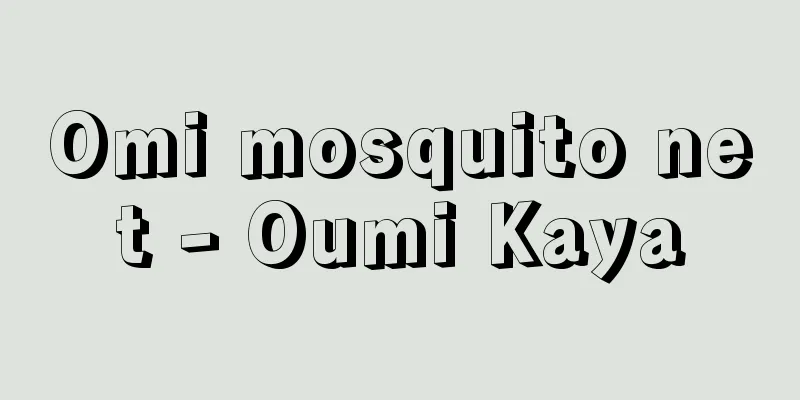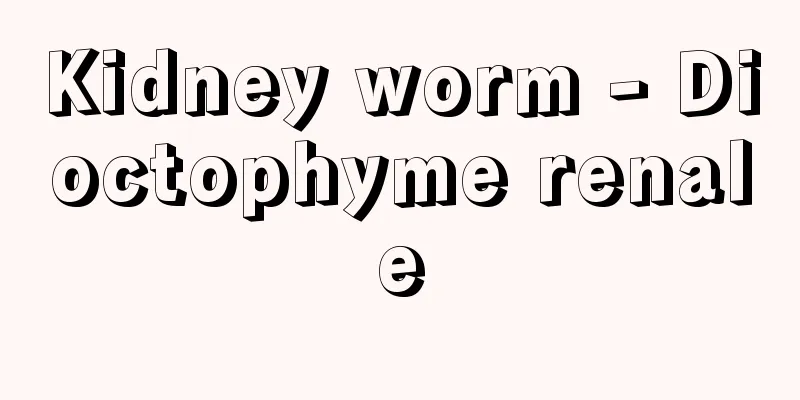Omi mosquito net - Oumi Kaya

|
Mosquito nets are a specialty of Omi (Shiga Prefecture). The main production areas are Hachiman in Gamo County and Nagahama in Sakata County, and they were called Hachiman mosquito nets and Nagahama mosquito nets (hama mosquito nets), respectively. In Hachiman, there were merchants who bought and sold Nara mosquito nets as early as the Tensho era (1573-92), but around the Keicho era (1596-1615), they started buying up local hemp thread, having it woven into mosquito nets, and selling them as Hachiman mosquito nets. During the Kan'ei era (1624-1644), they began importing large amounts of hemp thread from Echizen (Fukui Prefecture) and producing it, and by 1639 (Kan'ei 16), there were 17 mosquito net makers in the town, and by 1653 (Sho'o 2), they had established an agreement with the "Ebisu Society," a group of associates. During the Kanbun era (1661-73), the techniques for making mosquito nets were transmitted from Yawata to Nagahama, and it flourished as a side job for farmers. The heyday of Yawata mosquito nets was around the Kyoho and Genbun eras (1716-1741), when the number of members reached 3 groups - the old group, the new group, and the new new group - a total of 47 people. From around the Kansei era (1789-1801), Nagahama mosquito nets became the target of domestic production encouragement by the Hikone domain, and the quality improved and the industry flourished, but at the end of the Edo period, around the Ansei era (1854-1860), raw material producing areas such as Ono and Fukui in Echizen began direct production, which temporarily dealt a blow to the industry. Mosquito net wholesalers would sell the yarn they purchased to farmers in the town and nearby areas on a contract basis, and have the white mosquito net fabric dyed by a mosquito net dyer, who would then send the fabric to Edo and other places to be made into mosquito nets by retailers, or have it made in Yahata or Nagahama and sold as finished products. After the Meiji period, a power loom company was established in 1904 (Meiji 37), and raw yarn began to be sourced from Hokkaido and China. Even in 1951 (Showa 26), after the Second World War, annual production was about 300,000 nets. [Masuo Murai] Source: Shogakukan Encyclopedia Nipponica About Encyclopedia Nipponica Information | Legend |
|
近江(滋賀県)の特産である蚊帳。蒲生(がもう)郡八幡(はちまん)および坂田郡長浜を主産地とし、それぞれ八幡蚊帳、長浜蚊帳(浜蚊帳)とよばれた。八幡では早く天正(てんしょう)年間(1573~92)から奈良蚊帳を売買する商人がいたが、慶長(けいちょう)年間(1596~1615)ころになると地元の麻糸を買い集めて蚊帳を織らせ、八幡蚊帳として売り出すようになった。寛永(かんえい)(1624~44)になると越前(えちぜん)(福井県)から大量の麻糸を輸入して生産するに至り、1639年(寛永16)には町内蚊帳屋17軒、1653年(承応2)ころには仲間の「えびす講」で申合せを定めるまでに発展した。また寛文(かんぶん)年間(1661~73)には八幡から長浜に製作技術が伝わり、農家の副業として隆盛に赴いた。八幡蚊帳の盛期は享保(きょうほう)・元文(げんぶん)(1716~41)ころで、仲間も古組・新組・新々組の3組計47名に上った。長浜蚊帳は寛政(かんせい)(1789~1801)ころから彦根藩の国産奨励の対象となり品質も向上して盛況を迎えたが、幕末安政(あんせい)(1854~60)ころには越前の大野・福井など原料産地が直接生産を始め、一時打撃を受けたこともあった。蚊帳問屋は、仕入糸を町内・近郊農家に賃機(ちんばた)に出し、製品の白蚊帳地を蚊帳紺屋(こうや)に出して染めさせ、この蚊帳地を江戸その他各地に送って販売店で蚊帳に仕立てるほか、八幡・長浜で仕立てて製品として売り出すこともあった。明治以後は1904年(明治37)に動力織機(しょっき)の会社が生まれ、原料糸も北海道産・中国産をも用いるようになった。第二次世界大戦後の51年(昭和26)でも年産約30万帳を産した。 [村井益男] 出典 小学館 日本大百科全書(ニッポニカ)日本大百科全書(ニッポニカ)について 情報 | 凡例 |
<<: Oumi Kariyasu - Oumi Kariyasu
Recommend
Wang Chen (English spelling)
1720‐97 A literati painter during the Qianlong per...
Spontini, Gaspare Luigi Pacifico
Born: November 14, 1774. Majorati [Died] January 2...
vibrating roller
...To compact crushed stone, etc., the air pressu...
Tell Agrab
…The southern Mesopotamian city-states, which sho...
Askol'd i Dir (English spelling)
Prince of Kiev, Russia, before the Rurikid dynasty...
La Granja (English spelling)
This villa was built by King Philip V of Spain (re...
OSCE - OSCE
Organization for Security and Co-operation in Euro...
Velvet beetle - Velvet beetle
An insect of the family Scarabaeidae in the order ...
Brachymeria obscurata (English spelling)
...They sometimes parasitize parasitic wasps and ...
Eastern Nine Tombs (English: Tonggunǔng)
Located in the vast hills of Inchang-ri, Guri-myeo...
Siam rosewood (English spelling)
…It is a wood of the genus Dalbergia , which belo...
Anne Sullivan
...Born in Alabama. At the age of two, she became...
Guest room - kyaakuma
A room in a house used to receive guests. The fir...
Via Cassia
A road built by the Romans that ran from Rome thro...
Labor Thanksgiving Day - Labor Thanksgiving Day
November 23rd. A national holiday for "celeb...









